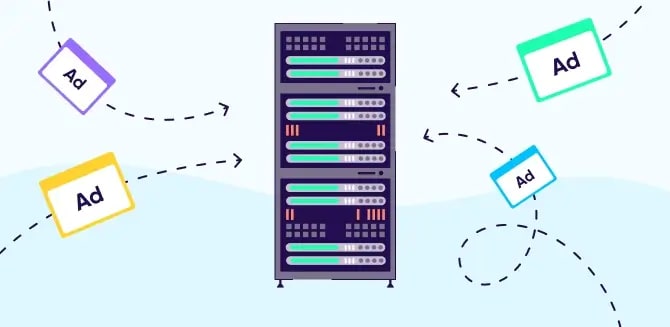Programmatic Advertising - What It Is and How It Works


Programmatic advertising has revolutionized the way brands connect with their audiences online. As a digital marketing consultant, I have personally witnessed how this technology-driven strategy has changed the advertising industry. However, what is programmatic advertising, and how does it operate? In-depth discussion of programmatic advertisements, their differences from traditional display ads, and the most recent developments and insights influencing this ever-evolving industry will all be covered in this blog post.
What Is Programmatic Advertising?
Programmatic advertising is the automated process of buying and selling digital ad space in real-time using algorithms and artificial intelligence (AI). In contrast to the traditional approach involving manual negotiations and insertion orders, programmatic advertising enables speed, efficiency, and data-based processes.
What Is the Difference Between Programmatic Ads and Display Ads?
Despite their frequent interchangeability, display ads and programmatic advertising are not the same.
- Display Ads: These are the visual advertisements (images, videos, banners) you see on websites. You can buy and place them manually through direct deals with publishers.
- Programmatic Ads: This is the process of using technology to automatically purchase and place those display ads (or other ad formats).
Marketers favor programmatic advertising because it provides dynamic pricing, improved targeting, and increased efficiency.
In essence, programmatic advertising is the how, while display ads are the what.
Who Uses Programmatic Ads? And Who Uses Display Ads?
Who Uses Programmatic Ads?
Businesses of all sizes, from startups to multinational corporations, use programmatic advertising. Particularly active in this area are the travel, finance, e-commerce, and automotive sectors.
For example, Amazon and Netflix heavily rely on programmatic ads to retarget users and drive conversions.
Who Uses Display Ads?
Businesses of all sizes use display ads, particularly those with less sophisticated targeting requirements or smaller budgets.
For example, Local businesses might use display ads to promote their services on specific websites or platforms.
How Does Programmatic Advertising Work?
A sophisticated ecosystem of platforms and technologies underpins programmatic advertising. This is a condensed explanation:
- Advertiser Sets Parameters: The advertiser defines their target audience, budget, and campaign goals.
- Real-Time Bidding (RTB): When a user visits a website, an auction happens in milliseconds. Advertisers bid for the ad space, and the highest bidder’s ad is displayed.
- Ad Serving: The winning ad is instantly delivered to the user’s device.
- Performance Tracking: The platform tracks metrics like impressions, clicks, and conversions, allowing advertisers to optimize campaigns in real-time.
This entire process is powered by Demand-Side Platforms (DSPs) and Supply-Side Platforms (SSPs), which connect advertisers with publishers.
Programmatic Advertising Platforms
A range of platforms that facilitate automated ad buying and selling are essential to programmatic advertising.
Together, these platforms guarantee effective ad placements and expedite the advertising process.
1. Demand-Side Platforms (DSPs)
Advertisers purchase ad inventory from various publishers and ad exchanges using DSPs. They enable real-time campaign optimization, budget management, and targeting parameter setting for marketers. Among the most widely used DSPs are:
- Google Display & Video 360 (DV360): A comprehensive DSP that integrates with Google’s suite of advertising tools, offering advanced targeting, cross-channel campaign management, and robust analytics.
- The Trade Desk: A leading independent DSP known for its transparency, user-friendly interface, and access to premium inventory across display, video, CTV, and audio channels.
- Amazon DSP - Ideal for advertisers looking to leverage Amazon's vast audience network for e-commerce and brand marketing.
2. Supply-Side Platforms (SSPs)
Publishers sell their ad inventory to advertisers through SSPs. By linking them to several DSPs and guaranteeing that their inventory is sold for the best price, these platforms assist publishers in maximizing their profits. Among the examples are:
- Google Ad Manager: A widely used SSP that helps publishers manage and monetize their ad inventory across desktop, mobile, and video.
- PubMatic: A global SSP that specializes in real-time bidding (RTB) and offers tools for inventory optimization and yield management.
- OpenX: An SSP that focuses on delivering high-quality programmatic ad experiences while prioritizing user privacy and compliance.
3. Ad Exchanges
Digital marketplaces known as ad exchanges are where publishers and advertisers can purchase and sell ad inventory. They facilitate real-time auctions by serving as a bridge between DSPs and SSPs. Famous ad exchanges consist of:
- Google AdX: One of the largest and most popular ad exchanges, offering access to premium inventory and advanced targeting options.
- AppNexus (now part of Xandr): A robust ad exchange known for its transparency and scalability, catering to both advertisers and publishers.
4. Data Management Platforms (DMPs)
By gathering, evaluating, and segmenting audience data, DMPs are an essential component of programmatic advertising, even though they are not the only one. Targeting strategies on DSPs are then informed by this data. Lotame and Salesforce DMP (formerly Krux) are two examples.
What Are the Types of Programmatic Advertising?
Programmatic advertising comes in several forms, each suited to different campaign goals:
- Real-Time Bidding (RTB): The most common type, where ad inventory is bought and sold in real-time auctions.
- Programmatic Direct: Advertisers buy ad space directly from publishers at a fixed price, bypassing auctions.
- Private Marketplaces (PMPs): Invitation-only auctions where premium publishers offer high-quality inventory to select advertisers.
- Programmatic Guaranteed: A hybrid model where advertisers and publishers agree on fixed terms, similar to traditional ad buying but with automation.
How Much Does Programmatic Advertising Cost?
The cost of programmatic advertising varies widely depending on factors like targeting, ad format, and competition. On average:
- CPM (Cost Per Thousand Impressions): $1 to $10
- CPC (Cost Per Click): $0.50 to $2
- CPA (Cost Per Acquisition): $10 to $50
Programmatic advertising often offers better ROI compared to traditional methods due to its precision and efficiency.
How Do I Run Programmatic Ads?
Running programmatic ads involves the following steps:
- Define Your Goals: Are you aiming for brand awareness, lead generation, or sales?
- Choose a Platform: Select a Demand-Side Platform (DSP) like Google Display & Video 360 or The Trade Desk that aligns with your budget and needs.
- Set Your Budget & Bidding Strategy: Decide how much you’re willing to spend daily or per campaign, and set CPM, CPC, or CPA bidding goals.
- Target Your Audience: Use data to define your audience based on demographics, interests, and behaviors.
- Create Your Ad: Design compelling visuals and copy that resonate with your audience.
- Launch and Optimize: Monitor performance and tweak your campaign for better results.
Digital Advertising vs. Programmatic Advertising
While all programmatic advertising is digital, not all digital advertising is programmatic.
- Digital Advertising: A broad term that includes any digital ad, from social media ads to search engine marketing.
- Programmatic Advertising: A subset of digital advertising focused on automation and data-driven targeting.
Programmatic advertising excels in scalability and efficiency, making it a preferred choice for large-scale campaigns.
Final Thoughts
Programmatic advertising is a game-changer for digital marketers, offering unparalleled efficiency, precision, and scalability. As the industry continues to evolve, staying ahead of trends like AI-driven targeting and connected TV (CTV) advertising will be key to success.
If you’re ready to explore programmatic advertising for your business, feel free to contact me for a personalized strategy. Together, we can unlock the full potential of this powerful tool.
Related Posts
The Future of SEO: The State of SEO i...
The digital marketing landscape is undergoing a massive transformation with the emergence of AI-powered search. Google’s Search Generative Experience (SGE), ChatGPT, and Bing Copilot are redefinin...
The Future of Paid Ads in the AI Era
Digital advertising has long been the lifeline for businesses seeking rapid growth, exposure, and increased conversions. From Google Ads to Meta’s advanced audience targeting, paid media has been o...
There are no comments yet.

